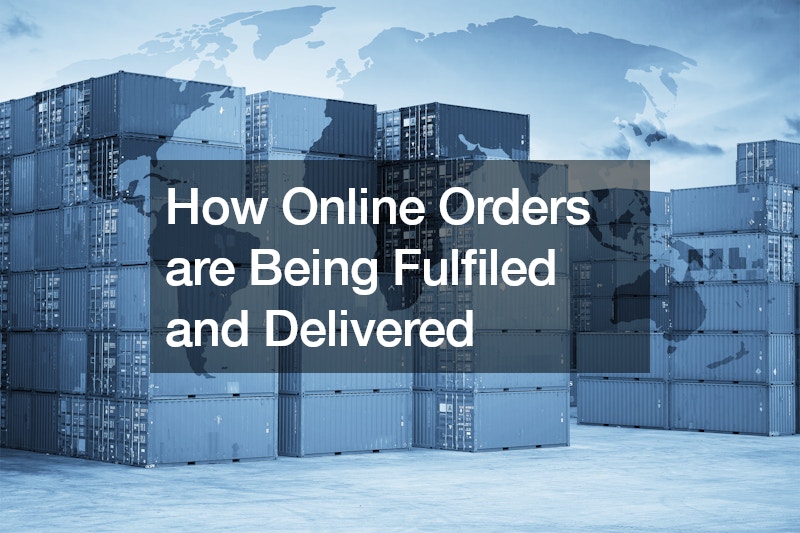In today’s digital age, the process of fulfiling and delivering online orders has become increasingly sophisticated and crucial for businesses striving to meet customer expectations. This article explores how online orders are fulfiled and delivered, highlighting the key steps involved and the role of technology in optimizing this process.
Evolution of Order Fulfilment:
Order fulfilment encompasses a series of steps, starting from receiving the customer’s order to delivering the product to their doorstep. Traditionally, this process was largely manual, involving labor-intensive tasks such as picking, packing, and shipping items from warehouses. However, with the rise of e-commerce, the demand for efficient and accurate order fulfilment has necessitated significant advancements in this area.
The Order Fulfilment Process:
Receiving and Storing Inventory: Upon receiving orders, businesses must manage their inventory effectively. This involves storing products in warehouses or fulfilment centers strategically located to minimize shipping times.
Processing Orders: Once an order is received, it needs to be processed swiftly. This includes verifying payment, checking stock availability, and preparing the order for shipment.
Picking and Packing: This crucial step involves retrieving items from inventory (picking) and carefully packaging them (packing) to ensure they reach customers undamaged.
Shipping the Order: Once packed, orders are dispatched for shipping using various carriers such as postal services or private logistics companies. Tracking information is provided to customers to monitor the status of their orders.
Handling Returns: In cases where customers request returns or exchanges, businesses must have processes in place to handle these efficiently, ensuring customer satisfaction.
Importance of Effective Order Fulfilment:
Efficient order fulfilment is paramount for businesses, as it directly impacts the customer experience and overall profitability. Delays, errors, or inaccuracies in fulfiling orders can lead to dissatisfied customers, negative reviews, and loss of revenue. Therefore, businesses strive to streamline and optimize their order fulfilment processes to meet customer expectations and stay competitive in the market.
Role of Technology in Order Fulfilment:
Technology plays a pivotal role in modern order fulfilment, enabling businesses to automate and optimize various aspects of the process. Inventory management software allows companies to track stock levels in real-time, ensuring adequate inventory is available to fulfil orders promptly. Order processing systems automate order verification and routing, reducing manual errors and processing times. Furthermore, advanced algorithms help businesses intelligently select the most efficient fulfilment methods based on factors such as inventory availability, shipping costs, and delivery timelines.
The Rise of Clothing Fulfilment Companies:
In the retail sector, particularly in the fashion industry, specialized clothing fulfilment companies have emerged to cater to the unique needs of apparel brands. These companies offer end-to-end solutions for order fulfilment, including inventory management, garment handling, and customized packaging. By partnering with a clothing fulfilment company, fashion brands can focus on core activities like design and marketing while outsourcing the complexities of order fulfilment to experts in the field.
As e-commerce continues to thrive and consumer expectations for fast and seamless delivery increase, the demand for efficient order fulfilment processes grows exponentially. In response, businesses are continually innovating and investing in technologies to enhance their fulfilment capabilities.
Advanced Technologies Driving Order Fulfilment:
Warehouse Automation: To expedite the picking and packing process, many companies are implementing warehouse automation solutions such as robotic systems and conveyor belts. These technologies help optimize warehouse layouts, increase picking accuracy, and reduce labor costs.
Artificial Intelligence (AI) and Machine Learning: AI-powered algorithms are revolutionizing order fulfilment by analyzing historical data to predict demand patterns, optimize inventory levels, and automate decision-making processes. Machine learning algorithms can also optimize routing and shipping decisions to minimize delivery times and costs.
Real-time Tracking and Visibility: Providing customers with real-time tracking information enhances transparency and builds trust. Advanced tracking technologies, such as GPS and RFID tags, enable businesses to monitor the movement of products throughout the fulfilment process, from the warehouse to the customer’s doorstep.
Predictive Analytics: Predictive analytics tools help businesses anticipate future demand, identify potential supply chain disruptions, and proactively mitigate risks. By leveraging data analytics, companies can optimize inventory management, reduce stockouts, and improve overall supply chain efficiency.
Challenges and Solutions in Order Fulfilment:
Last-Mile Delivery: The final leg of the delivery process, known as last-mile delivery, presents challenges such as traffic congestion, delivery delays, and high costs. To overcome these challenges, companies are exploring innovative solutions such as route optimization algorithms, drone delivery, and crowdshipping.
Returns Management: Handling returns efficiently is essential for customer satisfaction and retention. Advanced returns management systems use AI algorithms to streamline the returns process, minimize processing times, and identify trends to reduce future returns.
Omni-channel Fulfilment: With the proliferation of online and offline sales channels, businesses must adopt omni-channel fulfilment strategies to meet customer demands for seamless shopping experiences. Integrated inventory management systems and order routing algorithms enable companies to fulfil orders from multiple channels efficiently.
The Future of Order Fulfilment:
Looking ahead, the future of order fulfilment is likely to be characterized by further integration of technologies such as Internet of Things (IoT), blockchain, and augmented reality (AR). IoT devices embedded in products and packaging will provide real-time data on product location and condition, while blockchain technology will enhance transparency and security in supply chain transactions. Additionally, AR applications may revolutionize the picking process by providing warehouse workers with real-time visual instructions and information overlays.
Conclusion:
In conclusion, the fulfilment and delivery of online orders have undergone significant transformation in recent years, driven by technological advancements and changing consumer expectations. Businesses must prioritize efficient and accurate order fulfilment to remain competitive in the digital marketplace. By leveraging technology and partnering with specialized fulfilment providers like clothing fulfilment companies, businesses can streamline their operations and deliver exceptional customer experiences from order placement to delivery.
.


